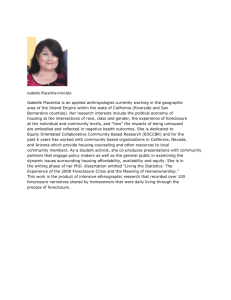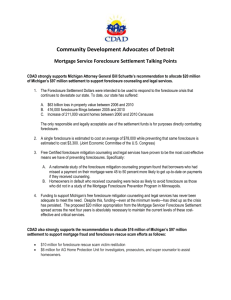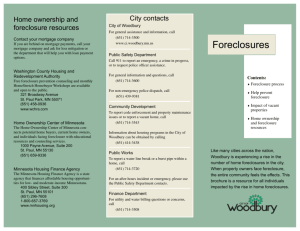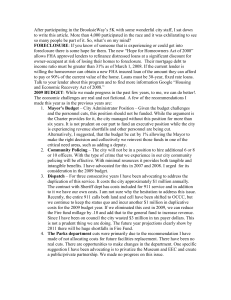Regulations spark plunge in foreclosures More people stay in
advertisement
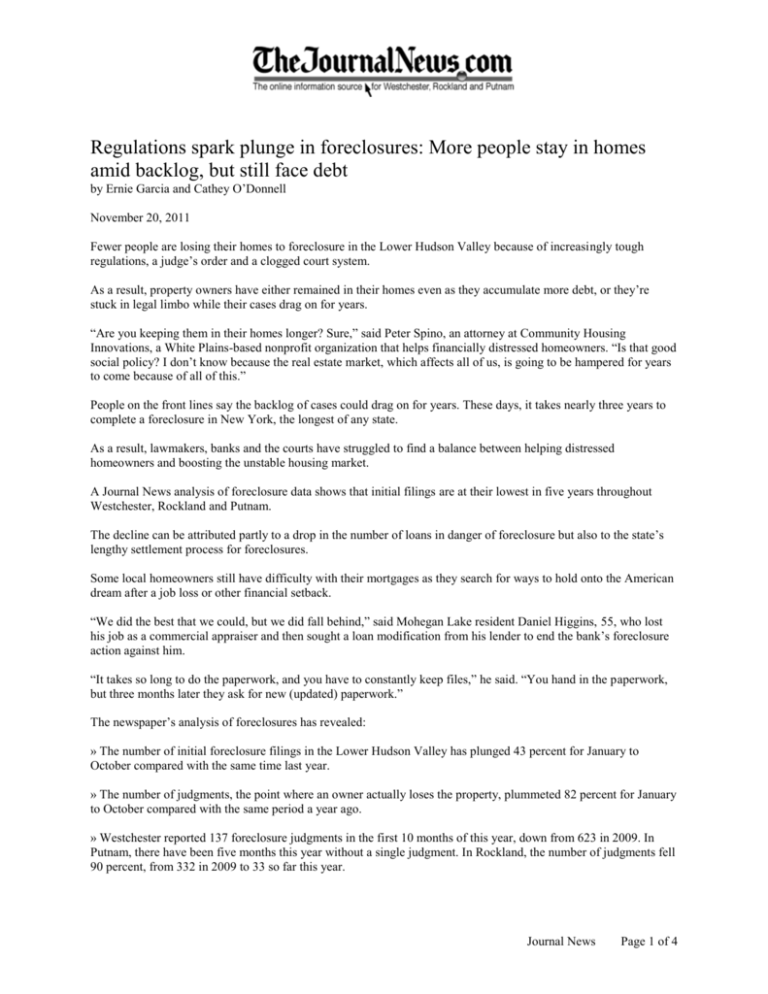
Regulations spark plunge in foreclosures: More people stay in homes amid backlog, but still face debt by Ernie Garcia and Cathey O’Donnell November 20, 2011 Fewer people are losing their homes to foreclosure in the Lower Hudson Valley because of increasingly tough regulations, a judge’s order and a clogged court system. As a result, property owners have either remained in their homes even as they accumulate more debt, or they’re stuck in legal limbo while their cases drag on for years. “Are you keeping them in their homes longer? Sure,” said Peter Spino, an attorney at Community Housing Innovations, a White Plains-based nonprofit organization that helps financially distressed homeowners. “Is that good social policy? I don’t know because the real estate market, which affects all of us, is going to be hampered for years to come because of all of this.” People on the front lines say the backlog of cases could drag on for years. These days, it takes nearly three years to complete a foreclosure in New York, the longest of any state. As a result, lawmakers, banks and the courts have struggled to find a balance between helping distressed homeowners and boosting the unstable housing market. A Journal News analysis of foreclosure data shows that initial filings are at their lowest in five years throughout Westchester, Rockland and Putnam. The decline can be attributed partly to a drop in the number of loans in danger of foreclosure but also to the state’s lengthy settlement process for foreclosures. Some local homeowners still have difficulty with their mortgages as they search for ways to hold onto the American dream after a job loss or other financial setback. “We did the best that we could, but we did fall behind,” said Mohegan Lake resident Daniel Higgins, 55, who lost his job as a commercial appraiser and then sought a loan modification from his lender to end the bank’s foreclosure action against him. “It takes so long to do the paperwork, and you have to constantly keep files,” he said. “You hand in the paperwork, but three months later they ask for new (updated) paperwork.” The newspaper’s analysis of foreclosures has revealed: » The number of initial foreclosure filings in the Lower Hudson Valley has plunged 43 percent for January to October compared with the same time last year. » The number of judgments, the point where an owner actually loses the property, plummeted 82 percent for January to October compared with the same period a year ago. » Westchester reported 137 foreclosure judgments in the first 10 months of this year, down from 623 in 2009. In Putnam, there have been five months this year without a single judgment. In Rockland, the number of judgments fell 90 percent, from 332 in 2009 to 33 so far this year. Journal News Page 1 of 4 Yet, more than 4,800 local homeowners, about 3 percent of the region’s active mortgages, were at least 90 days late on their loan payments, according to figures compiled for the New York Federal Reserve Bank. The figures were as of March 1 of this year. Helping hands The declining numbers don’t necessarily mean that foreclosures have come to a halt. “There is still a huge backlog of these cases or foreclosures that have never been brought forward yet,” said Robert Miss, chief development officer for Legal Services of the Hudson Valley, a nonprofit organization for those who can’t afford private legal help. In the next few months, Westchester’s homeowners will receive another helping hand from a court-supplied counselor who will shepherd them through the foreclosure process. A similar program is under way in the Bronx. “There are many homeowners who go to court and have had no one to advise them,” said state Sen. Jeff Klein, DBronx, who has pushed for tougher foreclosure regulations. Since 2007, the federal government has made at least four attempts to ease the national foreclosure crisis. Last month, President Barack Obama opened the Home Affordable Refinance Program to homeowners with underwater mortgages so they can take advantage of lower interest rates. The program would be restricted to those who haven’t missed any payments in the past year and who hold loans by Fannie Mae or Freddie Mac. In New York, regulations have let financially distressed homeowners remain in their properties, but some advocates say that isn’t always the best for them or their communities. In many cases, people seeking relief haven’t paid their mortgages for two years and still have failed to save any money. Yonkers resident Zach Taylor said he’s almost three months behind on his cooperative apartment’s second mortgage and that his lender wasn’t very helpful when he called. “They wanted pay stubs and they said, ‘You make so much money. How come you can’t pay the mortgage?’ ” said Taylor, who works at a building supplies retailer. Taylor explained that his lender’s financial calculations didn’t consider his utilities, food and unexpected expenses that come with raising children. State oversight New York has had some of the lowest foreclosure rates in the nation, mainly because of tough regulations that became even tougher during the last recession. Unlike New York, many states don’t require foreclosures to go through the court system. Before lenders can initiate a foreclosure in New York, they also must meet with the property owner for a courtrequired settlement conference. Those conferences are frequently postponed and can add 120 days to the pro-cess before an initial filing can proceed, said Michael Smith, president of the New York Bankers Association. Journal News Page 2 of 4 New York had one foreclosure filing for every 4,202 units, compared with Nevada where there was one for every 44 in the third quarter, according to RealtyTrac, which compiles national foreclosure statistics. “New York didn’t have the real estate bubble like the rest of the country,” said Daren Blomquist, a RealtyTrac spokesman. “In some places, it will take a matter of years, 2014 or longer, for many places to get back on solid footing.” In October 2010, New York’s Chief Judge Jonathan Lippman signed an order requiring lenders and attorneys to verify that all paperwork was accurate before a foreclosure could proceed. That halted the practice of “robo-signing,” where bank officials signed thousands of foreclosure documents without reviewing them and ensuring their accuracy. Last month, initial filings were down 54 percent and actual judgments plunged 85 percent in the Lower Hudson Valley from the same period a year earlier, when Lippman issued the order. “We understand the motivation of his order,” Smith said. “Clearly we have to protect the rights of property owners. Now we have to work to make the process more efficient.” Lippman has defended his order by saying the integrity of the judicial system was at risk. Many homeowners lost their properties as banks foreclosed on them without verifications that the documents presented to the courts were accurate. “If you can’t do that, then that tells you something about the quality, the credibility of the proceedings being brought,” Lippman said of his accuracy order. “So we’re trying to hold everybody accountable.” Falling behind Local lawmakers say the declining number of foreclosures shows that the process is working. The settlement conference forces lenders to negotiate with homeowners, Klein said. “Banks were very quick to foreclose on homeowners,” Klein said. “It’s always better to modify a mortgage before filing for a foreclosure.” Others, however, say many properties sit vacant or people remain in them without paying any of their debt as the process drags on. “It hurts the community, and it hurts the borrowers because their debt accumulates,” Smith said. “You also have local taxes involved that might not get paid.” Mount Vernon Councilman Steven Horton, co-chair of his city’s foreclosure task force, said that blight is a bigger problem than property taxes, which he said many banks pay. Vacant houses in a protracted foreclosure limbo have created eyesores in some Mount Vernon neighborhoods and lowered the property values of surroun-ding homes, Horton said. The banks bear some responsibility for the vacant homes because many aren’t maintained even after a completed foreclosure, Klein said. “It’s in the bank’s best interest to do everything possible to prevent a foreclosure,” Klein said. Journal News Page 3 of 4 Because of the lengthy foreclosure process, bank-ers have approached state lawmakers and Gov. Andrew Cuomo to find alternatives. One solution could involve negotiating conferences outside of the court system, which is used by about half of the states, Smith said. In the meantime, many homeowners are still falling behind on their mortgage payments. Higgins, for example, lost his full-time job in 2007 and he’s worked only part time since then, including stints in retail stores and for the U.S. Census Bureau. He said he contacted his mortgage lender when he began falling behind, but the bank officials would not speak to him until he was two payments behind. Spino recounted how some of his clients were in homes that lost more than $100,000 of value and still agreed to mortgage modifications that left them with huge sums due at the end of 30-year contracts. “A comparable home to rent is probably going to cost the same, so they figure why not keep this even if I’m under water,” Spino said. “It’s not a good financial decision.” Journal News Page 4 of 4

